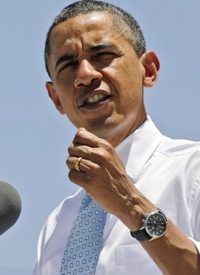
In 1964 President Adolfo López Mateos of Mexico and President Lyndon B. Johnson of the United States met on the border separating their two nations to celebrate the official end of the 100-year-long dispute regarding the precise location of the international boundary.
This dispute, known as the Chamizal border conflict, began around 1852 when the river that separated the two countries — the Rio Grande (called the Rio Bravo in Mexico) — began shifting course so as to confuse the location of the border agreed upon in the Treaty of Guadalupe that ended the Mexican American War. As part of the settlement of the border dispute, the United States received 193 acres of Cordova Island from Mexico.
On May 10, 2011, President Barack Obama stood at the Chamizal National Memorial in El Paso, Texas, a park dedicated to commemorating the settlement of the Chamizal border dispute, and addressed a crowd gathered to hear a speech designed to declare the full scope of the Obama administration’s plan to “fix our broken immigration system.”
In the proclamation (entitled “E Pluribus Unum”), the President summarized his view of the current immigrant situation:
Others avoid immigration laws by overstaying their visas. Regardless of how they came, the overwhelming majority of these folks are just trying to earn a living and provide for their families. (Applause.) But we have to acknowledge they’ve broken the rules. They’ve cut in front of the line. And what is also true is that the presence of so many illegal immigrants makes a mockery of all those who are trying to immigrate legally.
That approach sounds rather reasonable. We as a nation have benefited from the hard work of immigrants and we want to encourage the best and brightest from around the world to use their talents to help America remain the world’s mightiest nation. That’s the gist of the President’s message. Later in the speech, he puts a bit of a finer point on it:
So one way to strengthen the middle class in America is to reform the immigration system so that there is no longer a massive underground economy that exploits a cheap source of labor while depressing wages for everybody else. I want incomes for middle-class families to rise again. (Applause.) I want prosperity in this country to be widely shared. (Applause.) I want everybody to be able to reach that American dream. And that’s why immigration reform is an economic imperative. It’s an economic imperative. (Applause.) And reform will also help to make America more competitive in the global economy.
Today, we provide students from around the world with visas to get engineering and computer science degrees at our top universities. (Applause.) But then our laws discourage them from using those skills to start a business or a new industry here in the United States. Instead of training entrepreneurs to stay here, we train them to create jobs for our competition. That makes no sense. In a global marketplace, we need all the talent we can attract, all the talent we can get to stay here to start businesses — not just to benefit those individuals, but because their contribution will benefit all Americans.
Look at Intel, look at Google, look at Yahoo, look at eBay. All those great American companies, all the jobs they’ve created, everything that has helped us take leadership in the high-tech industry, every one of those was founded by, guess who, an immigrant (Applause.)
So we don’t want the next Intel or the next Google to be created in China or India. We want those companies and jobs to take root here. (Applause.) Bill Gates gets this. He knows a little something about the high-tech industry. He said, “The United States will find it far more difficult to maintain its competitive edge if it excludes those who are able and willing to help us compete.”
So immigration is not just the right thing to do. It’s smart for our economy. It’s smart for our economy. (Applause.) And it’s for this reason that businesses all across America are demanding that Washington finally meet its responsibilities to solve the immigration problem. Everybody recognizes the system is broken. The question is, will we finally summon the political will to do something about it? And that’s why we’re here at the border today.
There the President stood, at the border, specifically at a monument erected to celebrate a peaceful resolution to competing claims for land on that border, and he told the cheering throng that the reason we have a problem with the immigration system as it is is because we aren’t welcoming immigrants in a manner that would encourage their lawful entry. Our laws and our approach to those who try to cross the southern border and seek to realize the American dream are destructive of those dreams and lock the fulfillment of those dreams behind fences and walls.
Is there irony in the fact that President Obama chose the Chamizal National Memorial as the site for his “let’s fix immigration” speech? This spot where the United States was ceded land according to legal mutual agreement is a stone’s throw from where thousands of Mexicans (and invaders from many other nations merely passing through Mexico on their way to the United States) flout the laws of the states and the federal government enacted to prevent such illegal entry.
We are, through our failure to adequately protect our mutually recognized border with Mexico, tacitly surrendering millions of acres belonging to the sovereign states that lie along that border to the control of criminals and coyotes who have all but completely occupied large swaths of territory within the boundaries of the states of Arizona, New Mexico, and Texas.
In response to this flow of illegal immigrants through the porous southern border, states have finally begun asserting their right to protect themselves. The Tenth Amendment to the Constitution explicitly protects the retention by the states and the people of any power not specifically granted to the national government. In the case of the power to regulate immigration, the Constitution makes no such grant to the feds, thus lawfully leaving the matter to the discretion of the several states.
No matter the how inspiring the rhetoric or how “good for America” the proposed comprehensive overhaul of the federal immigration policy, the fact is that the Constitution of the United States nowhere grants the national government the authority to regulate matters of immigration.
The majority of powers delegated to the Congress of the United States is contained within Article I, Section 8 of the Constitution. Therein are enumerated the powers ceded by the states and the people to the national legislature. Furthermore, not one of the roughly 20 powers given to Congress permits the regulation of immigration.
The closest the Constitution comes to placing anything even incidentally related to immigration within the bailiwick of Congress is found in the clause of Article I, Section 8 that empowers Congress to “establish an uniform Rule of Naturalization.” That’s it. There is no other mention of immigration in the text of the Constitution. Somehow, though, the enemies of the right of states to govern themselves have extrapolated from that scant reference to “naturalization” the exclusive and unimpeachable right to legislate in the arena of immigration.
The true message sent out from the Chamizal National Memorial should be that it is time for the states to reclaim territory that has been ceded incrementally over the past 200 years to the federal government as the proper constitutional boundary between those two sovereign entities has been redrawn. The states must demand that the legitimate boundary between the rights of the states and the limited powers of the federal government be restored according to the demarcation mutually agreed upon in Philadelphia in 1787.
Photo: President Barack Obama speaks about immigration reform at Chamizal National Memorial Park in El Paso, Texas, Tuesday, May 10, 2011: AP Images



